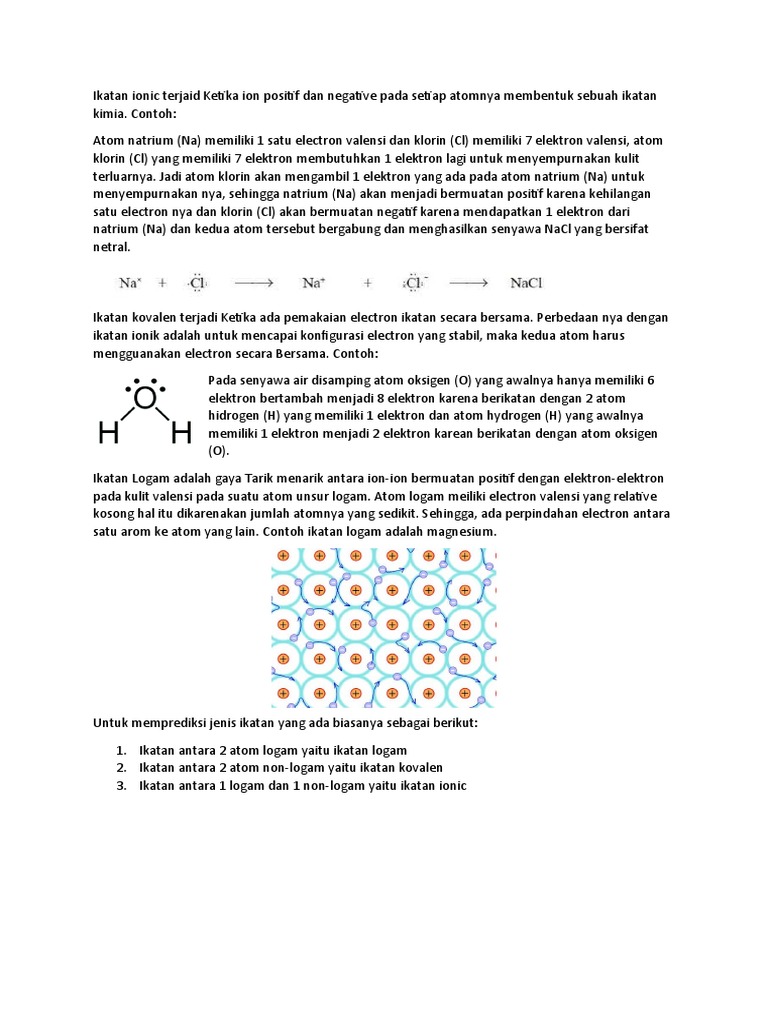Chemical bonds are the unseen forces that hold matter together, shaping the molecular architecture of all substances around us. Understanding the different types of chemical bonds is essential for grasping the behavior of materials in nature and the intricate tapestry of chemical reactions. This exploration will cover the primary types of chemical bonds: ionic bonds, covalent bonds, metallic bonds, and hydrogen bonds, while also touching upon the nuances of intermolecular interactions and resonance structures.
Ionic Bonds
Ionic bonding occurs when electrons are transferred from one atom to another, facilitating the formation of charged particles known as ions. This type of bond typically manifests between metals and nonmetals, where the electropositivity of metals leads to a propensity to relinquish electrons, while nonmetals, due to their high electronegativity, eagerly accept these electrons.
The quintessential example of ionic bonding can be observed in sodium chloride (NaCl). Sodium (Na), with its single valence electron in the outer shell, easily loses this electron, resulting in the formation of a positively charged sodium ion (Na+). Conversely, chlorine (Cl), which possesses seven valence electrons, gains this electron to become a negatively charged chloride ion (Cl–). The electrostatic attraction between these oppositely charged ions engenders a robust ionic lattice structure, characterized by its high melting point and solubility in polar solvents like water.
Covalent Bonds
Covalent bonding, in stark contrast to ionic bonding, involves the sharing of electron pairs between atoms. This phenomenon is predominantly observed among nonmetal elements, which have comparable electronegativities, facilitating an equilibrium state wherein atoms coexist harmoniously. Covalent bonds may be categorized into two primary types—single and multiple bonds. A single covalent bond, represented by a pair of shared electrons, exemplifies a straightforward union, as seen in diatomic hydrogen (H2). Multiple bonds, including double and triple bonds, feature the sharing of two and three pairs of electrons, respectively, as illustrated by ethylene (C2H4) and acetylene (C2H2).
The concept of bond polarity is crucial when delving into covalent bonds, as the disparity in electronegativity between bonded atoms can lead to polar covalent bonds. For instance, the bond between oxygen and hydrogen in water (H2O) displays such polarity, creating a dipole moment that contributes to water’s unique properties, such as its high surface tension and solvent capabilities. The geometric configuration of covalently bonded molecules, governed by the principles of VSEPR theory (Valence Shell Electron Pair Repulsion), also merits attention, as it elucidates the three-dimensional arrangement of atoms in a molecule.
Metallic Bonds
Metallic bonding introduces a fascinating paradigm wherein atoms within a metal lattice collectively share electrons in an extensive sea of delocalized electrons. This electrostatic attraction between positively charged metal cations and the free-moving electrons accounts for the characteristic properties of metals, such as malleability, ductility, and electrical conductivity. The arrangement of atoms in a metallic structure can influence its properties; for example, face-centered cubic lattices typically exhibit superior ductility compared to body-centered cubic lattices.
The cohesive strength exhibited by metallic bonds enables the formation of alloys, wherein distinct metallic elements coalesce to create materials with customized properties. For instance, the amalgamation of iron and carbon yields steel, an alloy renowned for its exceptional tensile strength. The study of metallurgical principles unveils a realm of possibilities for material science and engineering, illustrating how the manipulation of metallic bonds can lead to advancements in technology and industry.
Hydrogen Bonds
While hydrogen bonds are not classified as true chemical bonds, they play a pivotal role in defining the structure and interactions of molecules, particularly in biological and aqueous systems. These weak attractions manifest between a hydrogen atom, covalently bonded to a highly electronegative atom (such as oxygen or nitrogen), and another electronegative atom. The classic example of hydrogen bonding is observed in water, where each water molecule can form up to four hydrogen bonds with neighboring molecules, resulting in a network that contributes to water’s high boiling point and role as a universal solvent.
In biological systems, hydrogen bonds are integral to the stability of proteins and nucleic acids. For instance, in the double helix structure of DNA, hydrogen bonds between complementary base pairs—adenine-thymine and guanine-cytosine—establish the foundation for genetic information storage and transmission. The transient nature of hydrogen bonds allows for the flexibility necessary for biological processes, emphasizing their importance in molecular biology and biochemistry.
Intermolecular Forces
Complementing intramolecular bonds, intermolecular forces govern the interactions between separate molecules and contribute to physical properties such as boiling points, melting points, and solubility. These forces include London dispersion forces, dipole-dipole interactions, and hydrogen bonding, each varying in strength and manifestation. Understanding these forces allows scientists to predict behavior in mixtures and solutions and informs various applications in materials science, pharmaceuticals, and environmental science.
Conclusion
The diverse types of chemical bonds—ionic, covalent, metallic, and hydrogen bonds—constitute the foundation of chemistry, shaping the molecular universe we inhabit. Each bond type offers unique insights into the behavior of materials, facilitating advances in scientific inquiry and technological innovation. The interplay between these bonds and the broader spectrum of interactions not only piques curiosity but also promises a deeper understanding of the natural world, igniting a passion for discovery that transcends conventional wisdom.












